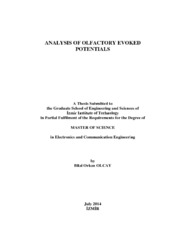Please use this identifier to cite or link to this item:
https://hdl.handle.net/11147/4205Full metadata record
| DC Field | Value | Language |
|---|---|---|
| dc.contributor.advisor | Savaci, Ferit Acar | - |
| dc.contributor.author | Olcay, Bilal Orkan | - |
| dc.date.accessioned | 2014-11-21T07:57:44Z | - |
| dc.date.available | 2014-11-21T07:57:44Z | - |
| dc.date.issued | 2014 | - |
| dc.identifier.uri | http://hdl.handle.net/11147/4205 | - |
| dc.description | Thesis (Master)--Izmir Institute of Technology, Electronics and Communication Engineering, Izmir, 2014 | en_US |
| dc.description | Includes bibliographical references (leaves: 141-150) | en_US |
| dc.description | xiv, 150 leaves | en_US |
| dc.description | Text in English; Abstract: Turkish and English | en_US |
| dc.description | Full text release delayed at author's request until 2017.08.11 | en_US |
| dc.description.abstract | With the growing opportunities of laboratories and measurement techniques, cognitive science attracts many researchers interest from other branches of science. In the literature, lack of studies related to the brain's responsiveness against the olfactory stimuli has been the main source of motivation for our work on this issue. In this thesis, it is examined by means of time-dependent wavelet entropy of Electroencephalographic (EEG) signals which is collected from individuals that how olfactory and trigeminal effective odor stimuli affects responsiveness of the brain. Significance and meaningfulness of the results are shown with statistical tests of average entropy in the discrete time windows. Due to its nature of small amplitude in comparison with ongoing EEG activity, it’s hard to observe the components of olfactory evoked potentials and trigeminal evoked potentials. In order to separate these components from ongoing EEG, different signal processing techniques have been employed in this thesis. And, findings from these techniques have been conveyed to statistical tests to determine the most suitable technique for that purpose. Additionally, a novel smell performance identification metric have been offered for clinical studies that is not affected by basal activity of brain and subjective review, for objective assessment of smell performance. Statistical test result have shown that, results of this technique which is performed on 19 participants, and their TDI scores obtained from Sniffin’ Stick test battery, are in a strong correlation. | en_US |
| dc.language.iso | en | en_US |
| dc.publisher | Izmir Institute of Technology | en_US |
| dc.rights | info:eu-repo/semantics/openAccess | en_US |
| dc.subject | Olfactory evoked potentials trigeminal | en_US |
| dc.subject | Event-related potentials | en_US |
| dc.subject | Single trial evoked potentials EEG | en_US |
| dc.subject | Sense of smell | en_US |
| dc.subject | Wavelet transform | en_US |
| dc.subject | Enhancement factor | en_US |
| dc.title | Analysis of Olfactory Evoked Potentials | en_US |
| dc.title.alternative | Olfaktör Uyarılmış Potansiyellerin Analizi | en_US |
| dc.type | Master Thesis | en_US |
| dc.institutionauthor | Olcay, Bilal Orkan | - |
| dc.department | Thesis (Master)--İzmir Institute of Technology, Electrical and Electronics Engineering | en_US |
| dc.relation.publicationcategory | Tez | en_US |
| local.message.claim | 2023-01-27T11:42:22.210+0300 | * |
| local.message.claim | |rp02429 | * |
| local.message.claim | |submit_approve | * |
| local.message.claim | |dc_contributor_author | * |
| local.message.claim | |None | * |
| dc.identifier.wosquality | N/A | - |
| dc.identifier.scopusquality | N/A | - |
| item.cerifentitytype | Publications | - |
| item.languageiso639-1 | en | - |
| item.openairetype | Master Thesis | - |
| item.openairecristype | http://purl.org/coar/resource_type/c_18cf | - |
| item.fulltext | With Fulltext | - |
| item.grantfulltext | open | - |
| crisitem.author.dept | 01.01. Units Affiliated to the Rectorate | - |
| Appears in Collections: | Master Degree / Yüksek Lisans Tezleri | |
Files in This Item:
| File | Description | Size | Format | |
|---|---|---|---|---|
| 10035453.pdf | MasterThesis | 3.6 MB | Adobe PDF |  View/Open |
CORE Recommender
Page view(s)
262
checked on Apr 14, 2025
Download(s)
202
checked on Apr 14, 2025
Google ScholarTM
Check
Items in GCRIS Repository are protected by copyright, with all rights reserved, unless otherwise indicated.